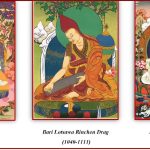Tamang Buddhist Federation Nepal | September 7, 2025

Sakya Tradition in Buddhism
The term Sakya literally means “grey or pale earth.”
The first Sakya monastery was built on a hillside in Tibet where the soil had a distinctive grey-white color, giving the tradition its name.
Origin
The Sakya tradition was founded in the 11th century by Khön Könchok Gyalpo (1034–1102).
It is rooted in the teachings brought from India by great masters such as Vīrupā and Atiśa.
The tradition is especially known for the Lamdré (ལམ་འགྲེལ་, “Path and Its Fruit”) teachings, which integrate the entire path to enlightenment with its ultimate realization.
Key Characteristics Integration of Philosophy and Tantra The Sakya school balances the Sutra (philosophical teachings) and Tantra (esoteric practices) traditions.
The Lamdré system uniquely unifies the path (the process of practice) and the fruit (the attainment of Buddhahood). Emphasis on Vinaya and Scholarship Strong focus on scriptural study, debate, and composition.
Observance of the monastic discipline (Vinaya) is highly respected. Hereditary Leadership Leadership in the Sakya tradition has historically remained within the Khön family lineage.
This hereditary transmission of authority makes it distinct from other Tibetan Buddhist schools. Core Practices Lamdré system at the heart of the tradition.
Mantra recitation, meditation, yogic practices, and tantric rituals.
Historical Significance
During the 13th–14th centuries, the Sakya school also held political authority in Tibet.
Two of its greatest figures were Sakya Pandita (1182–1251) and his nephew Chögyal Phakpa (1235–1280), who expanded the tradition’s influence.
Phakpa was appointed as “Imperial Preceptor” by Kublai Khan of the Mongol Empire, establishing the Sakya as both religious and political leaders in Tibet.
Present Day
Today, Sakya remains one of the four main schools of Tibetan Buddhism.
The head of the tradition is known as the Sakya Trizin (“Throne Holder of Sakya”).
The Sakya tradition continues to flourish in Tibet, Nepal (especially in the Kathmandu Valley), India, Bhutan, and in Western countries.
In short, the Sakya tradition is one of the four great schools of Tibetan Buddhism, founded by the Khön lineage, emphasizing the Lamdré teachings, the integration of Sutra and Tantra, strict Vinaya, and a unique hereditary system of leadership, while also playing a crucial role in Tibet’s political history.
Categories: Sakya
Tags:

September 25, 2025

September 25, 2025

September 16, 2025

September 7, 2025